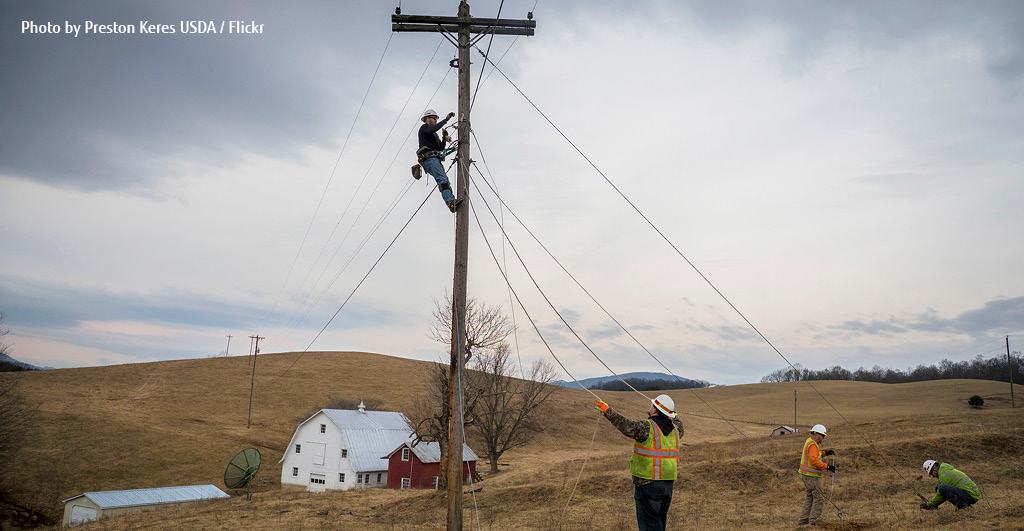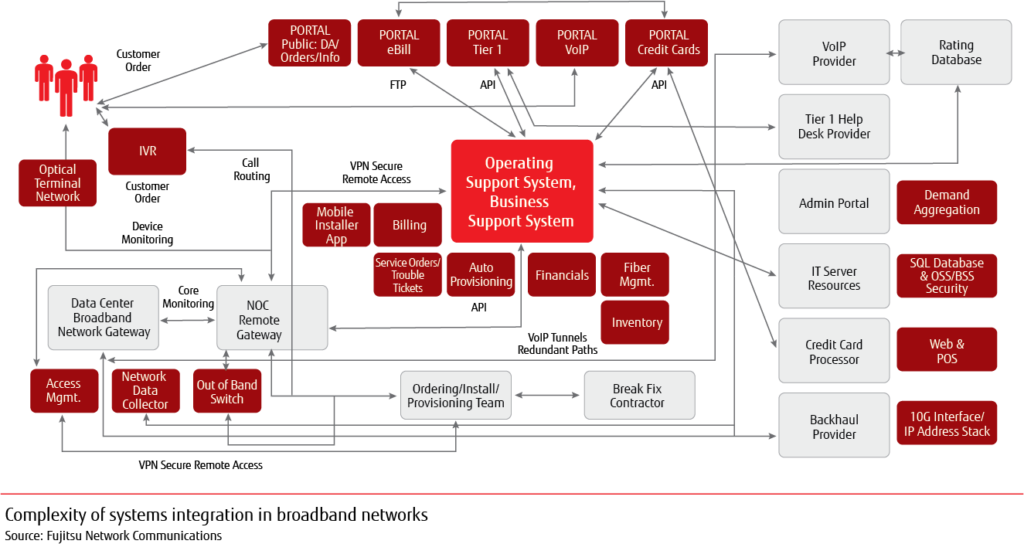
Increasing numbers of rural electric co-ops and municipal utilities are deciding to build community-based fiber broadband networks and offer their residents high-speed fiber services. Their aim is to provide new and necessary broadband service to the community, and stimulate economic development as a result. With a growing track record of success stories over the last few years, it seems that we’re finally on our way to bridging America’s digital divide.
So, what do you need to know to add your electric co-op or utility to the list of broadband successes?
For most electric co-ops and municipal utilities, the fiber-based, broadband business is unfamiliar territory. Once the decision is made, your team will need to master many disciplines, some of which are more critical to success than others:
- Systems integration
- Funding
- Make-ready
- Cybersecurity
- Billing
- Engineering
- Capital plan
- Reporting requirements
- Customer service
- Marketing/branding
- Easements
- Staffing
- Project management
- Electronics
Some of these challenges, such as easements, funding, capital planning and customer service, are things that your staff is already familiar with and can handle in-house. But there are three big ones that tend to give utilities and co-ops the most trouble (and in some cases, end up derailing the project). Recent industry research indicates strongly that the three biggest problem areas are:
- Project Management
- Systems Integration
- Make Ready
Each of these disciplines is critical to the project’s success, so let’s take a look at all three, since a project has the best chance of staying on-time and on-budget if they are done well. We’ll dive into the most common mistakes organizations make and discuss how to avoid them and ensure your project stays on track, under budget, and exceeds your community’s expectations.
Success Factor 1: Broadband Project Management
Project management encompasses the day-to-day coordination, communication, recordkeeping, and reporting of all work efforts by staff, suppliers and contractors to keep the project on-time and on-budget. When it’s not done right, the results can be damaging.
Common Project Management Problems
Sloppy communication causes confusion and misunderstandings between vendors, workers, and stakeholders. Overlooking regulatory and compliance procedures or attempting to cut corners very often leads to project halts and delays. Poorly coordinated material deliveries cause delays and idle construction teams. Methodical records management is essential. Purchase orders, invoicing, and recordkeeping mistakes can result in compliance issues today and accounting problems tomorrow. Problems, and there will be problems, need to be resolved quickly to keep the project on track.
Successful Project Management
To avoid these kinds of missteps, utilities and co-ops should carefully evaluate who will be leading the project management effort. At a minimum, they should have the following qualifications:
- Experience, specifically in broadband network technologies, deployment, and operations: This is critical, as the project manager is the link between your organization and those on the technical side who will be implementing your vision. So, just having a PMP certification is not enough. They must be fluent in broadband and fiber best practices and have a solid understanding of the most prevalent network problems and how to resolve them.
- A thorough understanding of the roles and responsibilities of all suppliers, vendors and contractors: The project manager needs to know who is “on the hook” for this or that and understand how the performance of supplier A affects the cost of contractor B.
- Communicate, communicate, and communicate! The project manager is your ringmaster. The only way to know who’s doing what, when, and where is to talk; not only talk, but be able to listen, understand and make adjustments on the fly as needed.
Success Factor 2: Broadband Systems Integration
Successfully building and launching a broadband network involves a massive integration effort. A broadband network is composed of dozens of operations and business subsystems and procedures. These must all be engineered, tested, and documented to ensure that they work together efficiently and effectively. It’s every bit as complex as your power generation and distribution network; the key difference is that your staff is intimately familiar with what it takes to integrate and operate power systems, but broadband is another animal entirely.

Common Problems
Co-ops and utilities that struggle in this area typically underestimate the scope and complexity of system integration. They often resort to trial-and-error steps to develop process flows and handoffs between groups. Failure to ensure compatibility among equipment, software suppliers and contractor systems is a common problem. This often leads to finger-pointing between staff, suppliers, and contractors. An under-resourced system integration team will usually encounter many date slips and cost overruns as staff work overtime to get the new operation up and running
Successful Systems Integration
Utilities and electric co-ops can prevent these issues by ensuring there is a lead network integrator who is ultimately responsible and accountable for all aspects of systems integration. The lead integrator is typically the most technically experienced person on the project. They should be multidisciplined, with experience in all aspects of broadband internet service creation. It is critical to remember that the lead integrator serves as the central authority for resolving processes and operations issues. In other words, their job is to ensure the integration effort doesn’t just work but works in the most efficient manner. For this reason, it’s typically better if systems integration and project management are handled by the same company. Since most integration work will be done prior to and during service launch, its best to use a contractor partner for this heavy lift.
Success Factor 3: Make-Ready
Make-ready means dotting every regulatory “i” and crossing every “t.” This step involves obtaining the regulatory, ownership, and engineering approvals for, potentially, thousands of pole attachments and right-of-way easements across the new service area. This must be done efficiently while avoiding excessive costs for cable moves and pole replacements. Every detail must be managed or else protracted negotiations can cause delays that could throw the project off schedule.
Common Problems
Make-ready and detailed engineering in the outside plant have to work closely. The make-ready and detailed engineering efforts in the outside plant must be closely aligned and coordinated. Trying to start the detailed engineering in an area before doing the walkouts can lead to gaps in knowledge for the detailed engineers and ultimately cause re-work and delays. Another common problem is failure to adhere to standards, regulations or ordinances, any of which could lead to violations, fines, and construction delays. We have seen projects where inexperience in dealing with pole owners or other carrier tenants causes prolonged disputes and unplanned costs particularly with extra pole replacements.
Successful Make-Ready
To keep the make-ready phase as clean and tight as possible, it’s essential to engage with the project manager and remain in close contact throughout. Where two different companies are doing make-ready and project management, be sure you pay attention to any handoff issues and ensure these are addressed as soon as they occur.
The make-ready team also needs to do its homework regarding pole owners and agencies and their standard practices, expectations, and restrictions. If there are opportunities for reciprocating agreements, that is preferable. The make-ready team will also need to be well-versed in load capacities and NESC standards, since they’re likely to be involved with field verification, load calculations, and standards compliance standards during field engineering. Assigning a make-ready lead who has strong negotiation skills is big plus that can help secure the best pole position among competing cable placements.
Value of Planning and Partnership
Lastly, the value of advance planning and thoughtful preparation cannot be overstated. Detailed discussion involving all the principals, vendors, departments, and oversight agencies, and other stakeholders will help catch potential conflicts and answer questions well before they turn costly. Be prepared to invest time and effort in roundtable sessions, because it can take several days to adequately cover all the angles and details of the project. Don’t expect to knock it out in a couple of hours—but the time spent will be well worth it!
Planning, building, integrating and operating your own broadband network is a large undertaking. You don’t have to go it alone—and nor should you. As a global broadband network integrator, Fujitsu partners with electric co-ops, municipalities and public power utilities every day. Working hand-in-hand with these valued ecosystem partners, we help design, build, operate and manage broadband networks that transform communities and improve the lives of the businesses and people who live and work in them. We’re here to for you, as a partner and guide. Lean on our experience.